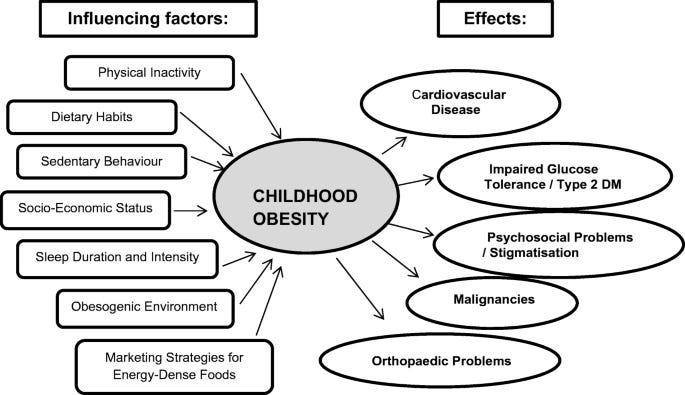
Brown (2014) stated that overweight and obesity (OO) has doubled over the last two decades. Although genetics play a role in the outcome of such conditions, it would be fallacious to conclude genetic predispositions as a singular impetus behind OO. Environmental factors, specifically the interplay between environment and genetics, are a more likely cause of OO than genetics alone (Brown, 2014).

Risk factors, which contribute to OO, include having at least one overweight parent, coming from a low-income family, being of African American, Hispanic, or Native American/Native Alaskan descent, and being diagnosed with a condition that limits mobility (Brown, 2014). Additionally, consuming diets high in sugars and sedentary behaviors are also risk factors associated with OO (Brown, 2014). Such risk factors, as an aggregate, contribute to hypertension, dyslipidemia, insulin resistance, type 2 diabetes, sleep apnea, hepatic diseases, and lowered self-esteem (Brown, 2014). Having considered said risk factors, many cannot be controlled that are genetic in nature (i.e., race/ethnicity). However, risk factors that are modifiable include nutrition and physical activity.

Eating habits of adolescents are not static in nature; they fluctuate throughout adolescence in relation to psychosocial and cognitive development (Brown, 2014). Adolescents also lead busy lives (i.e., school, social events, sports) leaving little time for food preparation. Consequently, many adolescents miss meals, snack, and over eat. Moreover, snack foods often include foods high in sugar, sodium, and fats such as: sodas, pizza, fruit drinks, dairy desserts, and salty snacks. The most common form of food consumed is fast food; foods, which are high in total saturated fats, low in fiber, and low in vitamins/minerals (Brown, 2014).

Adolescents can be encouraged to ask for water or milk instead of soft drinks, or order smaller portions, choose a salad instead of fries, or order grilled foods instead of those that are deep-fried (Brown, 2014). Additionally, when possible, eating as a family unit (away from television) has been associated with higher consumption of vegetables, fiber, folate, iron, and vitamin A/C/E/B6/B12 (Brown, 2014). Such behaviors are also found in adolescents who live away from home who choose to eat with others, rather than eating alone (Brown, 2014).

Physical activity has been encouraged among adolescents everyday or nearly everyday. Such recommendations are made because physical activity leads to many health benefits including aerobic endurance, strength, power, and flexibility. Additionally, physical activity is strongly associated with improved self-esteem and lower levels of anxiety and stress (Brown, 2014). Since physical activity is associated with psychologically and physiologically favorable outcomes, such behaviors are encouraged as they positively influence lifelong activity patterns (Brown, 2014). Recommendations to help encourage such activity would include family support, providing safe and convenient places to play, including the provision of sport equipment, and transportation to said events (Brown, 2014).
References
Brown, J. E. (2014). Nutrition through the life cycle (5th ed.). Stamford, CT: Cengage Learning.
-Michael McIsaac
